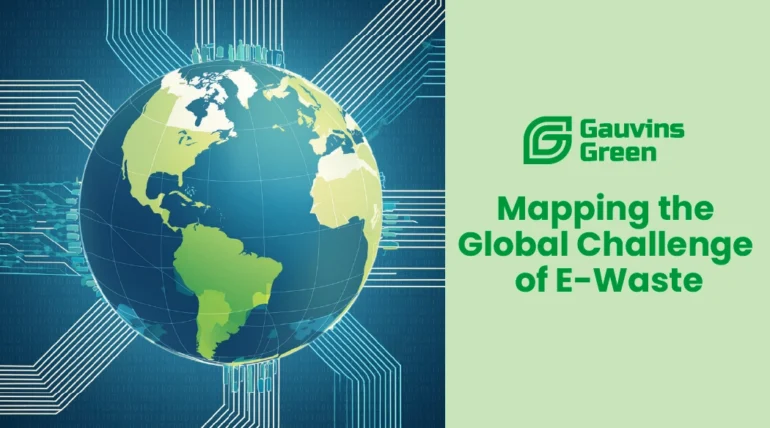Electronic waste or e-waste, represents one of the fastest-growing environmental concerns of the modern era. As technology advances at a breathtaking pace, the lifespan of electronic devices shortens, leading to a surge in discarded electronics worldwide. Understanding the global landscape of electronic waste generation and disposal is crucial to mitigating its environmental impact. This blog post delves into the world of electronic waste, utilizing compelling data to map out where it originates and where it ends up.
Global E-Waste Generation
The generation of e-waste is disproportionately high in developed nations, which are equipped with the technology and resources to purchase and discard electronic goods at a rapid rate. According to recent data, Norway leads the pack with an average of 28.5 kilograms of electronic waste generated per capita, followed closely by the United Kingdom and Denmark, with 24.9 and 24.8 kilograms per capita, respectively. These statistics highlight a troubling trend in consumer electronics: the cycle of buying, using, and disposing, of continues to accelerate, underscoring an urgent need for sustainable consumption practices.
E-Waste Shipping Routes and Receiving Countries
The journey of e-waste does not end at the bin. Much of it is shipped across continents, from countries like the USA, Canada, and member states of the European Union to various destinations in Asia and Africa. This map shows common routes leading from North America and Western Europe to countries such as India, China, and Pakistan. Additionally, African nations like Ghana and Nigeria have become frequent recipients of e-waste. This global transfer poses significant environmental and health challenges to receiving countries, often due to inadequate recycling technologies and regulations.
Legal and Illegal Aspects of E-Waste Disposal
While some e-waste is transported and processed under-regulated and relatively safe conditions, a significant portion is traded illegally. These illegal shipments are often disguised as legal exports or hidden among other goods to avoid the scrutiny of environmental regulations. The impact on the environment and public health in developing countries can be devastating, with toxins leaching into the soil and water supplies and causing widespread harm.
Gauvins Green’s Role and Initiatives
At Gauvins Green, we are committed to addressing the challenge of electronic waste through sustainable practices and innovative recycling technologies. Our initiatives aim to enhance the efficiency of e-waste recycling processes, reduce the environmental footprint of electronic goods, and raise awareness about the importance of e-waste management. We partner with local and international organizations to support the development of electronic waste legislation and encourage our community to participate in responsible recycling programs.
We urge you, our readers, to consider the lifecycle of your electronic devices and opt for more sustainable choices. Support e-waste recycling by disposing of your electronics at certified recycling centers, and advocate for policies that promote environmental sustainability. Together, we can make a significant impact on reducing electronic waste and safeguarding our planet for future generations.
Conclusion
The mapping of e-waste is more than just understanding its routes and origins; it’s about recognizing our role in its lifecycle and taking action to change the narrative. By supporting initiatives like those at Gauvins Green and making informed decisions about our electronic consumption, we contribute to a more sustainable and environmentally friendly world.
FAQ’s
What’s the deal with e-waste and why should I care?
E-waste is all about the old or broken tech cluttering up our drawers and landfills—think old smartphones, laptops, and even fridges. It’s a big deal because it’s packed with harmful chemicals that can pollute our planet and harm our health when not disposed of properly. Plus, recycling means recovering valuable materials and reducing the need to mine new ones.
Is e-waste that bad for the environment?
Absolutely! When tossed into landfills, e-waste can leak nasty chemicals into the soil and waterways, mess with ecosystems, and contribute to global warming. And with tech turnover faster than ever, the volume of electronic waste is just growing, making it a serious environmental issue.
How do I get rid of old gadgets without trashing the planet?
Great question! The best move is to drop off your old electronics at certified recycling centers where they’ll be safely handled or repurposed. Many electronic stores also offer trade-in programs that recycle your old gear responsibly. Keep an eye out for local e-waste recycling drives—super convenient and eco-friendly!
What can I do to cut down on e-waste?
Start by giving your electronics a longer life—repair instead of replace! When shopping, consider eco-friendly or refurbished models which are less taxing on resources. And when it’s time for a new gadget, think about recycling your old one. Every little bit helps to shrink the e-waste mountain!


